Evaluating Hurricane Irma: Disaster Management, Impact & Lessons USA
VerifiedAdded on 2023/06/13
|19
|4231
|328
Report
AI Summary
This report provides a comprehensive analysis of Hurricane Irma, a category 5 storm that significantly impacted the Caribbean Islands and Florida in 2017. It details the storm's formation, progression, and intensity, highlighting the management strategies employed by various governmental and non-governmental organizations, including FEMA. The report assesses the effectiveness of these strategies in terms of preparedness, response, and recovery, while also exploring lessons learned and faults identified in the management process. It further examines the ethical considerations in disaster management, particularly in relation to FEMA's guidelines and the impact of climate change, concluding with a reflection on the long-term recovery efforts and the importance of ecological preservation in mitigating future disaster risks. Desklib provides access to similar past papers and solved assignments for students.
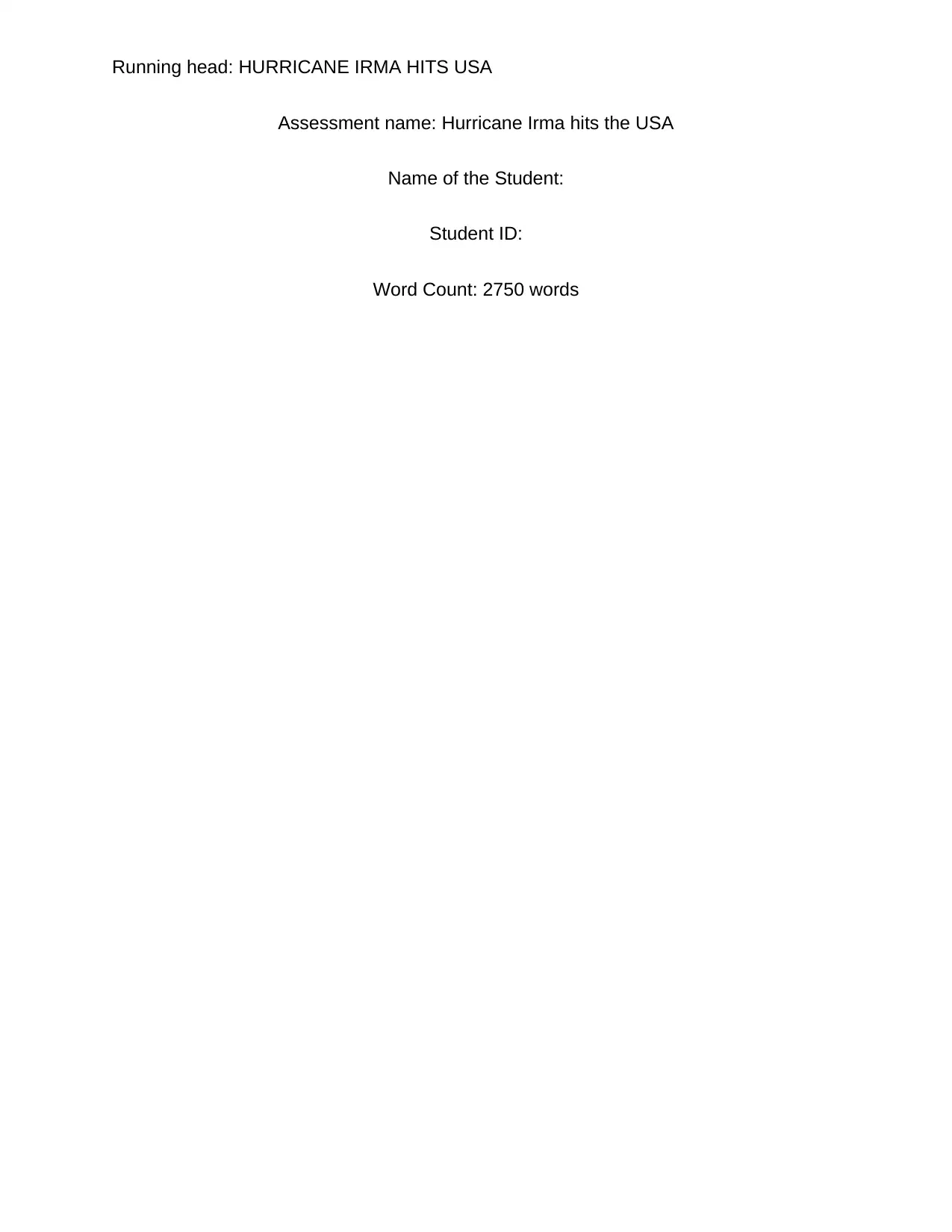
Running head: HURRICANE IRMA HITS USA
Assessment name: Hurricane Irma hits the USA
Name of the Student:
Student ID:
Word Count: 2750 words
Assessment name: Hurricane Irma hits the USA
Name of the Student:
Student ID:
Word Count: 2750 words
Paraphrase This Document
Need a fresh take? Get an instant paraphrase of this document with our AI Paraphraser
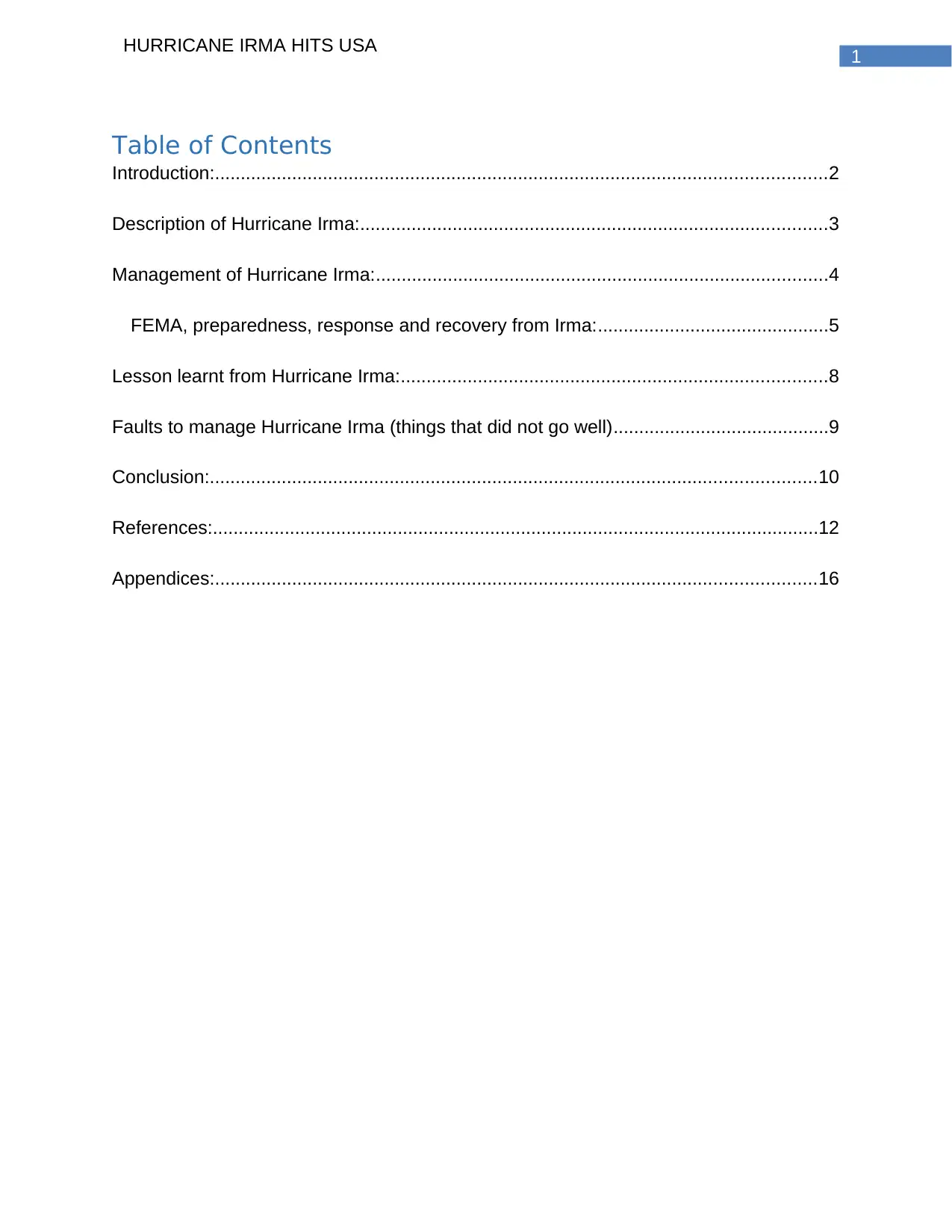
1
HURRICANE IRMA HITS USA
Table of Contents
Introduction:.......................................................................................................................2
Description of Hurricane Irma:...........................................................................................3
Management of Hurricane Irma:........................................................................................4
FEMA, preparedness, response and recovery from Irma:.............................................5
Lesson learnt from Hurricane Irma:...................................................................................8
Faults to manage Hurricane Irma (things that did not go well)..........................................9
Conclusion:......................................................................................................................10
References:......................................................................................................................12
Appendices:.....................................................................................................................16
HURRICANE IRMA HITS USA
Table of Contents
Introduction:.......................................................................................................................2
Description of Hurricane Irma:...........................................................................................3
Management of Hurricane Irma:........................................................................................4
FEMA, preparedness, response and recovery from Irma:.............................................5
Lesson learnt from Hurricane Irma:...................................................................................8
Faults to manage Hurricane Irma (things that did not go well)..........................................9
Conclusion:......................................................................................................................10
References:......................................................................................................................12
Appendices:.....................................................................................................................16
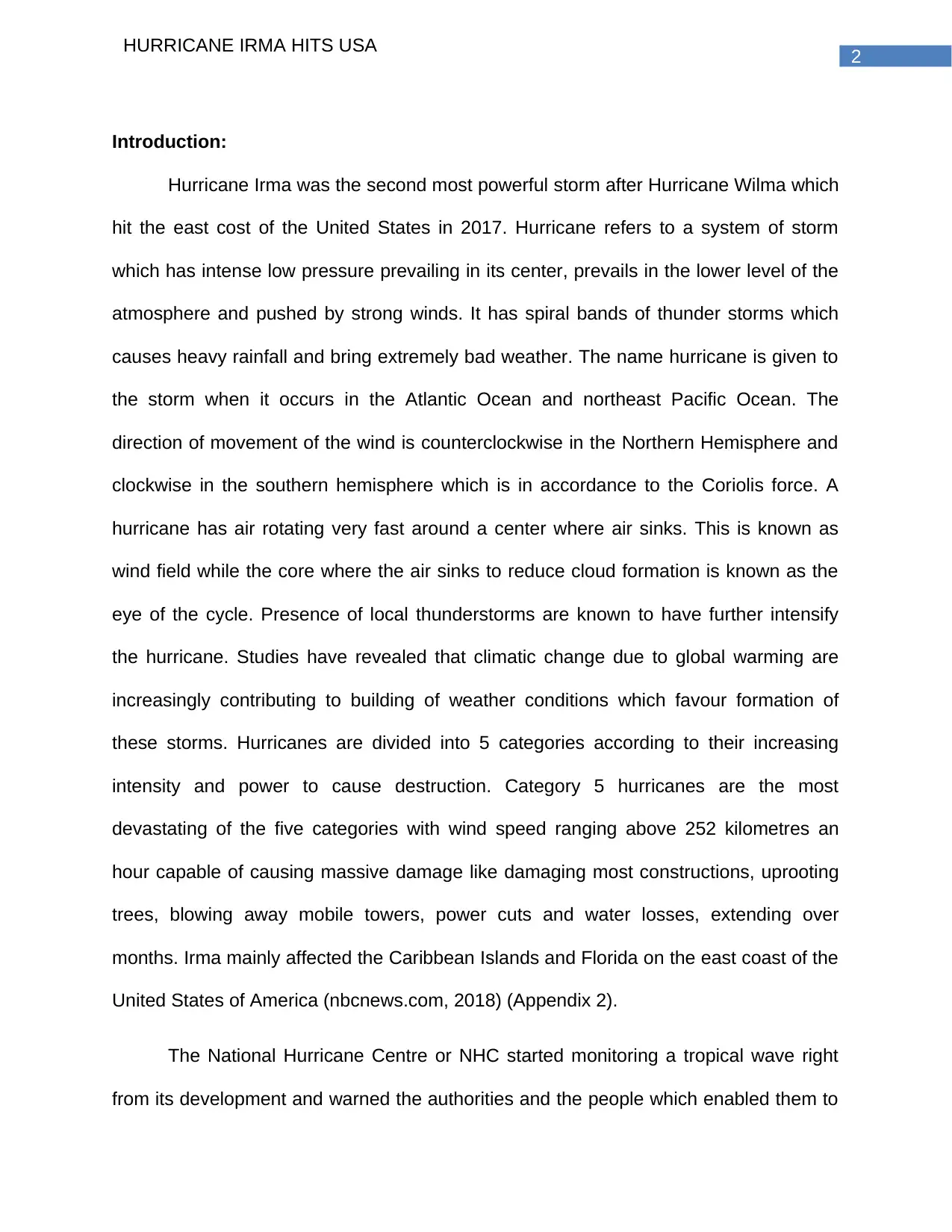
2
HURRICANE IRMA HITS USA
Introduction:
Hurricane Irma was the second most powerful storm after Hurricane Wilma which
hit the east cost of the United States in 2017. Hurricane refers to a system of storm
which has intense low pressure prevailing in its center, prevails in the lower level of the
atmosphere and pushed by strong winds. It has spiral bands of thunder storms which
causes heavy rainfall and bring extremely bad weather. The name hurricane is given to
the storm when it occurs in the Atlantic Ocean and northeast Pacific Ocean. The
direction of movement of the wind is counterclockwise in the Northern Hemisphere and
clockwise in the southern hemisphere which is in accordance to the Coriolis force. A
hurricane has air rotating very fast around a center where air sinks. This is known as
wind field while the core where the air sinks to reduce cloud formation is known as the
eye of the cycle. Presence of local thunderstorms are known to have further intensify
the hurricane. Studies have revealed that climatic change due to global warming are
increasingly contributing to building of weather conditions which favour formation of
these storms. Hurricanes are divided into 5 categories according to their increasing
intensity and power to cause destruction. Category 5 hurricanes are the most
devastating of the five categories with wind speed ranging above 252 kilometres an
hour capable of causing massive damage like damaging most constructions, uprooting
trees, blowing away mobile towers, power cuts and water losses, extending over
months. Irma mainly affected the Caribbean Islands and Florida on the east coast of the
United States of America (nbcnews.com, 2018) (Appendix 2).
The National Hurricane Centre or NHC started monitoring a tropical wave right
from its development and warned the authorities and the people which enabled them to
HURRICANE IRMA HITS USA
Introduction:
Hurricane Irma was the second most powerful storm after Hurricane Wilma which
hit the east cost of the United States in 2017. Hurricane refers to a system of storm
which has intense low pressure prevailing in its center, prevails in the lower level of the
atmosphere and pushed by strong winds. It has spiral bands of thunder storms which
causes heavy rainfall and bring extremely bad weather. The name hurricane is given to
the storm when it occurs in the Atlantic Ocean and northeast Pacific Ocean. The
direction of movement of the wind is counterclockwise in the Northern Hemisphere and
clockwise in the southern hemisphere which is in accordance to the Coriolis force. A
hurricane has air rotating very fast around a center where air sinks. This is known as
wind field while the core where the air sinks to reduce cloud formation is known as the
eye of the cycle. Presence of local thunderstorms are known to have further intensify
the hurricane. Studies have revealed that climatic change due to global warming are
increasingly contributing to building of weather conditions which favour formation of
these storms. Hurricanes are divided into 5 categories according to their increasing
intensity and power to cause destruction. Category 5 hurricanes are the most
devastating of the five categories with wind speed ranging above 252 kilometres an
hour capable of causing massive damage like damaging most constructions, uprooting
trees, blowing away mobile towers, power cuts and water losses, extending over
months. Irma mainly affected the Caribbean Islands and Florida on the east coast of the
United States of America (nbcnews.com, 2018) (Appendix 2).
The National Hurricane Centre or NHC started monitoring a tropical wave right
from its development and warned the authorities and the people which enabled them to
⊘ This is a preview!⊘
Do you want full access?
Subscribe today to unlock all pages.

Trusted by 1+ million students worldwide
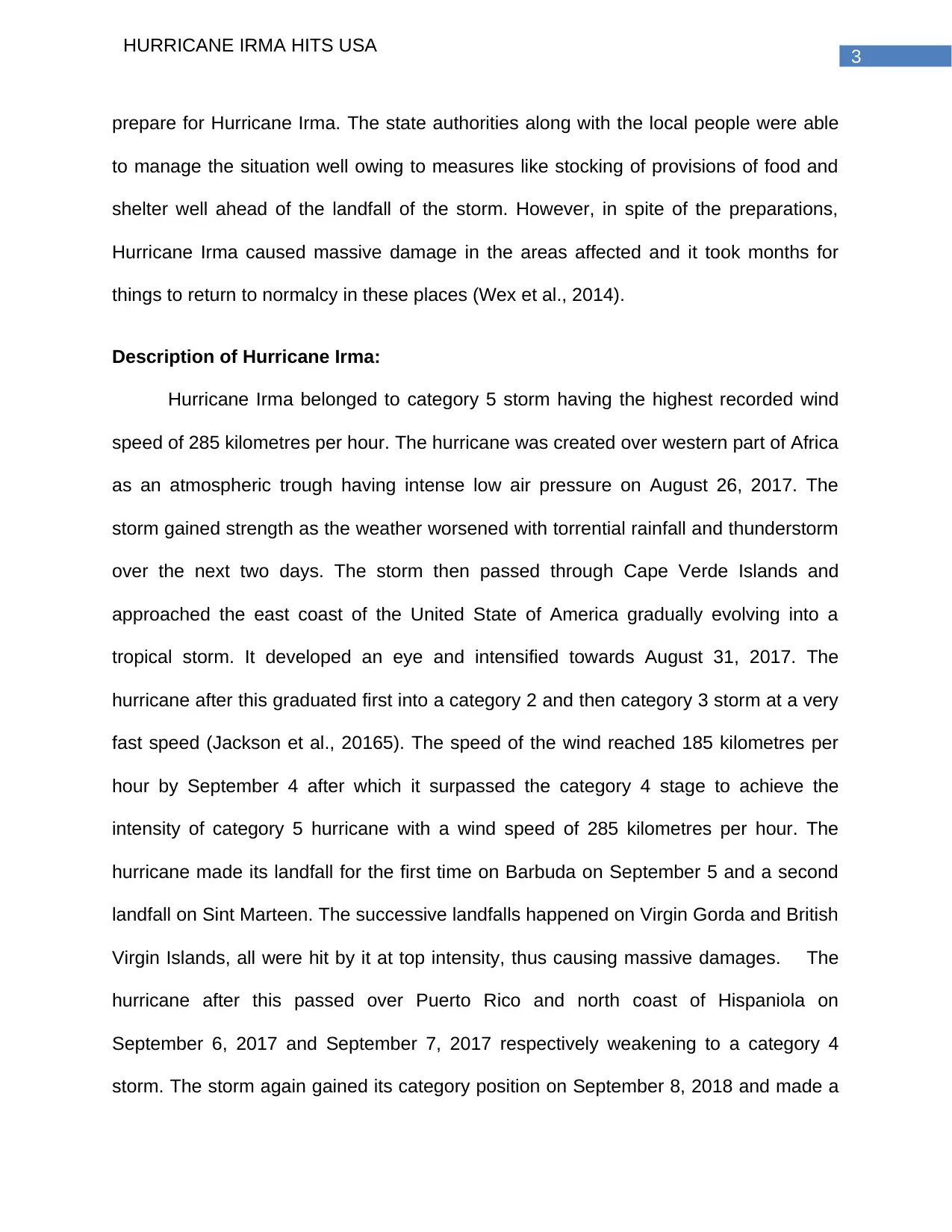
3
HURRICANE IRMA HITS USA
prepare for Hurricane Irma. The state authorities along with the local people were able
to manage the situation well owing to measures like stocking of provisions of food and
shelter well ahead of the landfall of the storm. However, in spite of the preparations,
Hurricane Irma caused massive damage in the areas affected and it took months for
things to return to normalcy in these places (Wex et al., 2014).
Description of Hurricane Irma:
Hurricane Irma belonged to category 5 storm having the highest recorded wind
speed of 285 kilometres per hour. The hurricane was created over western part of Africa
as an atmospheric trough having intense low air pressure on August 26, 2017. The
storm gained strength as the weather worsened with torrential rainfall and thunderstorm
over the next two days. The storm then passed through Cape Verde Islands and
approached the east coast of the United State of America gradually evolving into a
tropical storm. It developed an eye and intensified towards August 31, 2017. The
hurricane after this graduated first into a category 2 and then category 3 storm at a very
fast speed (Jackson et al., 20165). The speed of the wind reached 185 kilometres per
hour by September 4 after which it surpassed the category 4 stage to achieve the
intensity of category 5 hurricane with a wind speed of 285 kilometres per hour. The
hurricane made its landfall for the first time on Barbuda on September 5 and a second
landfall on Sint Marteen. The successive landfalls happened on Virgin Gorda and British
Virgin Islands, all were hit by it at top intensity, thus causing massive damages. The
hurricane after this passed over Puerto Rico and north coast of Hispaniola on
September 6, 2017 and September 7, 2017 respectively weakening to a category 4
storm. The storm again gained its category position on September 8, 2018 and made a
HURRICANE IRMA HITS USA
prepare for Hurricane Irma. The state authorities along with the local people were able
to manage the situation well owing to measures like stocking of provisions of food and
shelter well ahead of the landfall of the storm. However, in spite of the preparations,
Hurricane Irma caused massive damage in the areas affected and it took months for
things to return to normalcy in these places (Wex et al., 2014).
Description of Hurricane Irma:
Hurricane Irma belonged to category 5 storm having the highest recorded wind
speed of 285 kilometres per hour. The hurricane was created over western part of Africa
as an atmospheric trough having intense low air pressure on August 26, 2017. The
storm gained strength as the weather worsened with torrential rainfall and thunderstorm
over the next two days. The storm then passed through Cape Verde Islands and
approached the east coast of the United State of America gradually evolving into a
tropical storm. It developed an eye and intensified towards August 31, 2017. The
hurricane after this graduated first into a category 2 and then category 3 storm at a very
fast speed (Jackson et al., 20165). The speed of the wind reached 185 kilometres per
hour by September 4 after which it surpassed the category 4 stage to achieve the
intensity of category 5 hurricane with a wind speed of 285 kilometres per hour. The
hurricane made its landfall for the first time on Barbuda on September 5 and a second
landfall on Sint Marteen. The successive landfalls happened on Virgin Gorda and British
Virgin Islands, all were hit by it at top intensity, thus causing massive damages. The
hurricane after this passed over Puerto Rico and north coast of Hispaniola on
September 6, 2017 and September 7, 2017 respectively weakening to a category 4
storm. The storm again gained its category position on September 8, 2018 and made a
Paraphrase This Document
Need a fresh take? Get an instant paraphrase of this document with our AI Paraphraser
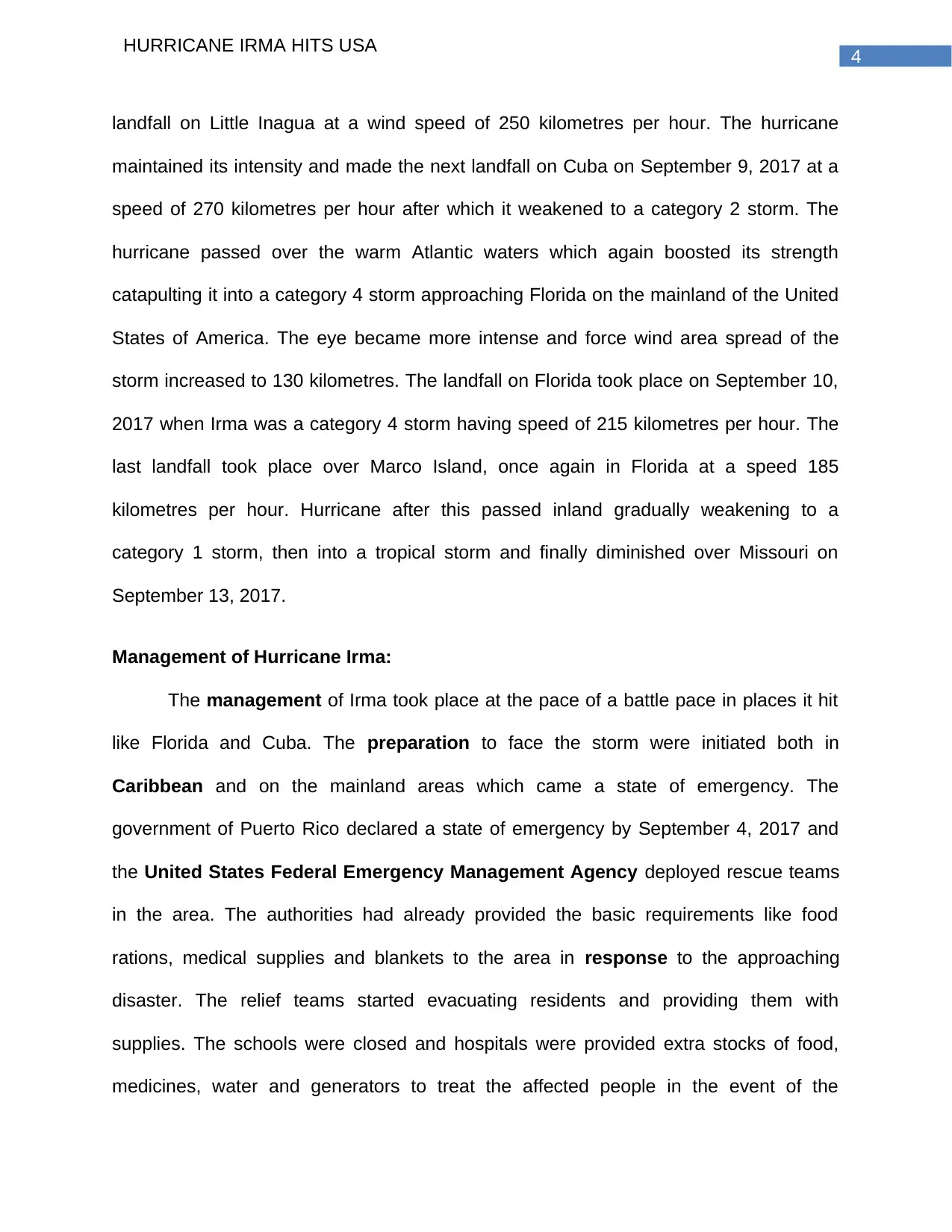
4
HURRICANE IRMA HITS USA
landfall on Little Inagua at a wind speed of 250 kilometres per hour. The hurricane
maintained its intensity and made the next landfall on Cuba on September 9, 2017 at a
speed of 270 kilometres per hour after which it weakened to a category 2 storm. The
hurricane passed over the warm Atlantic waters which again boosted its strength
catapulting it into a category 4 storm approaching Florida on the mainland of the United
States of America. The eye became more intense and force wind area spread of the
storm increased to 130 kilometres. The landfall on Florida took place on September 10,
2017 when Irma was a category 4 storm having speed of 215 kilometres per hour. The
last landfall took place over Marco Island, once again in Florida at a speed 185
kilometres per hour. Hurricane after this passed inland gradually weakening to a
category 1 storm, then into a tropical storm and finally diminished over Missouri on
September 13, 2017.
Management of Hurricane Irma:
The management of Irma took place at the pace of a battle pace in places it hit
like Florida and Cuba. The preparation to face the storm were initiated both in
Caribbean and on the mainland areas which came a state of emergency. The
government of Puerto Rico declared a state of emergency by September 4, 2017 and
the United States Federal Emergency Management Agency deployed rescue teams
in the area. The authorities had already provided the basic requirements like food
rations, medical supplies and blankets to the area in response to the approaching
disaster. The relief teams started evacuating residents and providing them with
supplies. The schools were closed and hospitals were provided extra stocks of food,
medicines, water and generators to treat the affected people in the event of the
HURRICANE IRMA HITS USA
landfall on Little Inagua at a wind speed of 250 kilometres per hour. The hurricane
maintained its intensity and made the next landfall on Cuba on September 9, 2017 at a
speed of 270 kilometres per hour after which it weakened to a category 2 storm. The
hurricane passed over the warm Atlantic waters which again boosted its strength
catapulting it into a category 4 storm approaching Florida on the mainland of the United
States of America. The eye became more intense and force wind area spread of the
storm increased to 130 kilometres. The landfall on Florida took place on September 10,
2017 when Irma was a category 4 storm having speed of 215 kilometres per hour. The
last landfall took place over Marco Island, once again in Florida at a speed 185
kilometres per hour. Hurricane after this passed inland gradually weakening to a
category 1 storm, then into a tropical storm and finally diminished over Missouri on
September 13, 2017.
Management of Hurricane Irma:
The management of Irma took place at the pace of a battle pace in places it hit
like Florida and Cuba. The preparation to face the storm were initiated both in
Caribbean and on the mainland areas which came a state of emergency. The
government of Puerto Rico declared a state of emergency by September 4, 2017 and
the United States Federal Emergency Management Agency deployed rescue teams
in the area. The authorities had already provided the basic requirements like food
rations, medical supplies and blankets to the area in response to the approaching
disaster. The relief teams started evacuating residents and providing them with
supplies. The schools were closed and hospitals were provided extra stocks of food,
medicines, water and generators to treat the affected people in the event of the
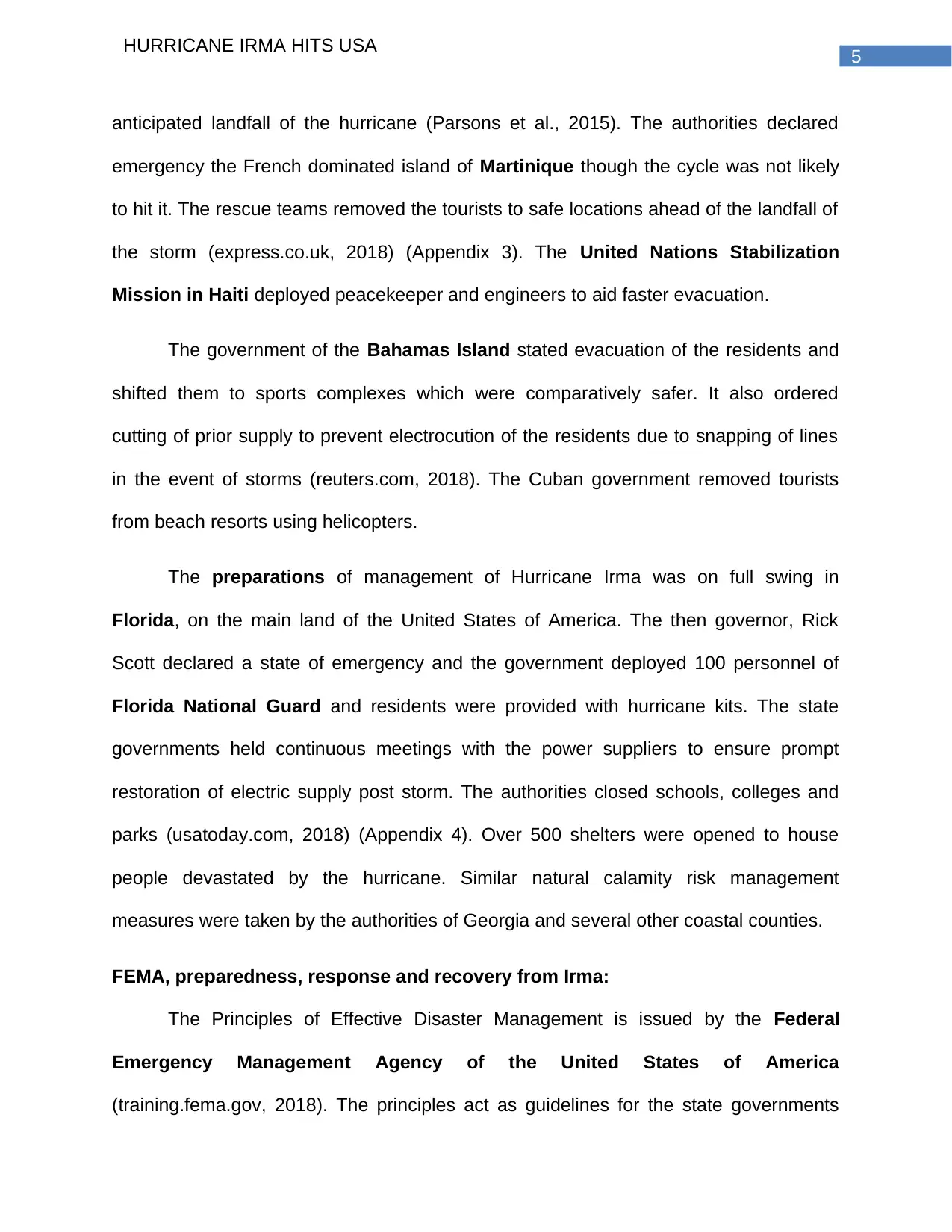
5
HURRICANE IRMA HITS USA
anticipated landfall of the hurricane (Parsons et al., 2015). The authorities declared
emergency the French dominated island of Martinique though the cycle was not likely
to hit it. The rescue teams removed the tourists to safe locations ahead of the landfall of
the storm (express.co.uk, 2018) (Appendix 3). The United Nations Stabilization
Mission in Haiti deployed peacekeeper and engineers to aid faster evacuation.
The government of the Bahamas Island stated evacuation of the residents and
shifted them to sports complexes which were comparatively safer. It also ordered
cutting of prior supply to prevent electrocution of the residents due to snapping of lines
in the event of storms (reuters.com, 2018). The Cuban government removed tourists
from beach resorts using helicopters.
The preparations of management of Hurricane Irma was on full swing in
Florida, on the main land of the United States of America. The then governor, Rick
Scott declared a state of emergency and the government deployed 100 personnel of
Florida National Guard and residents were provided with hurricane kits. The state
governments held continuous meetings with the power suppliers to ensure prompt
restoration of electric supply post storm. The authorities closed schools, colleges and
parks (usatoday.com, 2018) (Appendix 4). Over 500 shelters were opened to house
people devastated by the hurricane. Similar natural calamity risk management
measures were taken by the authorities of Georgia and several other coastal counties.
FEMA, preparedness, response and recovery from Irma:
The Principles of Effective Disaster Management is issued by the Federal
Emergency Management Agency of the United States of America
(training.fema.gov, 2018). The principles act as guidelines for the state governments
HURRICANE IRMA HITS USA
anticipated landfall of the hurricane (Parsons et al., 2015). The authorities declared
emergency the French dominated island of Martinique though the cycle was not likely
to hit it. The rescue teams removed the tourists to safe locations ahead of the landfall of
the storm (express.co.uk, 2018) (Appendix 3). The United Nations Stabilization
Mission in Haiti deployed peacekeeper and engineers to aid faster evacuation.
The government of the Bahamas Island stated evacuation of the residents and
shifted them to sports complexes which were comparatively safer. It also ordered
cutting of prior supply to prevent electrocution of the residents due to snapping of lines
in the event of storms (reuters.com, 2018). The Cuban government removed tourists
from beach resorts using helicopters.
The preparations of management of Hurricane Irma was on full swing in
Florida, on the main land of the United States of America. The then governor, Rick
Scott declared a state of emergency and the government deployed 100 personnel of
Florida National Guard and residents were provided with hurricane kits. The state
governments held continuous meetings with the power suppliers to ensure prompt
restoration of electric supply post storm. The authorities closed schools, colleges and
parks (usatoday.com, 2018) (Appendix 4). Over 500 shelters were opened to house
people devastated by the hurricane. Similar natural calamity risk management
measures were taken by the authorities of Georgia and several other coastal counties.
FEMA, preparedness, response and recovery from Irma:
The Principles of Effective Disaster Management is issued by the Federal
Emergency Management Agency of the United States of America
(training.fema.gov, 2018). The principles act as guidelines for the state governments
⊘ This is a preview!⊘
Do you want full access?
Subscribe today to unlock all pages.

Trusted by 1+ million students worldwide
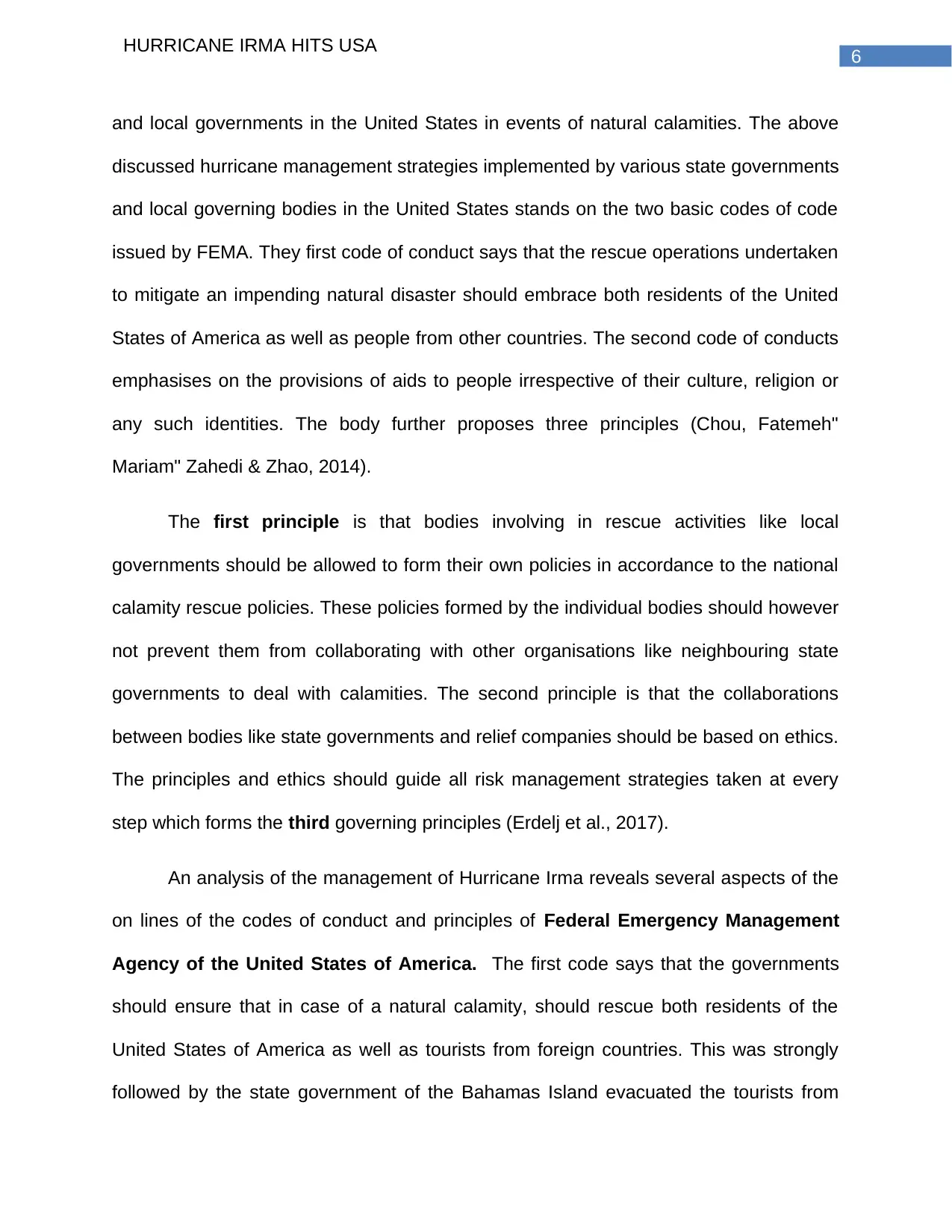
6
HURRICANE IRMA HITS USA
and local governments in the United States in events of natural calamities. The above
discussed hurricane management strategies implemented by various state governments
and local governing bodies in the United States stands on the two basic codes of code
issued by FEMA. They first code of conduct says that the rescue operations undertaken
to mitigate an impending natural disaster should embrace both residents of the United
States of America as well as people from other countries. The second code of conducts
emphasises on the provisions of aids to people irrespective of their culture, religion or
any such identities. The body further proposes three principles (Chou, Fatemeh"
Mariam" Zahedi & Zhao, 2014).
The first principle is that bodies involving in rescue activities like local
governments should be allowed to form their own policies in accordance to the national
calamity rescue policies. These policies formed by the individual bodies should however
not prevent them from collaborating with other organisations like neighbouring state
governments to deal with calamities. The second principle is that the collaborations
between bodies like state governments and relief companies should be based on ethics.
The principles and ethics should guide all risk management strategies taken at every
step which forms the third governing principles (Erdelj et al., 2017).
An analysis of the management of Hurricane Irma reveals several aspects of the
on lines of the codes of conduct and principles of Federal Emergency Management
Agency of the United States of America. The first code says that the governments
should ensure that in case of a natural calamity, should rescue both residents of the
United States of America as well as tourists from foreign countries. This was strongly
followed by the state government of the Bahamas Island evacuated the tourists from
HURRICANE IRMA HITS USA
and local governments in the United States in events of natural calamities. The above
discussed hurricane management strategies implemented by various state governments
and local governing bodies in the United States stands on the two basic codes of code
issued by FEMA. They first code of conduct says that the rescue operations undertaken
to mitigate an impending natural disaster should embrace both residents of the United
States of America as well as people from other countries. The second code of conducts
emphasises on the provisions of aids to people irrespective of their culture, religion or
any such identities. The body further proposes three principles (Chou, Fatemeh"
Mariam" Zahedi & Zhao, 2014).
The first principle is that bodies involving in rescue activities like local
governments should be allowed to form their own policies in accordance to the national
calamity rescue policies. These policies formed by the individual bodies should however
not prevent them from collaborating with other organisations like neighbouring state
governments to deal with calamities. The second principle is that the collaborations
between bodies like state governments and relief companies should be based on ethics.
The principles and ethics should guide all risk management strategies taken at every
step which forms the third governing principles (Erdelj et al., 2017).
An analysis of the management of Hurricane Irma reveals several aspects of the
on lines of the codes of conduct and principles of Federal Emergency Management
Agency of the United States of America. The first code says that the governments
should ensure that in case of a natural calamity, should rescue both residents of the
United States of America as well as tourists from foreign countries. This was strongly
followed by the state government of the Bahamas Island evacuated the tourists from
Paraphrase This Document
Need a fresh take? Get an instant paraphrase of this document with our AI Paraphraser
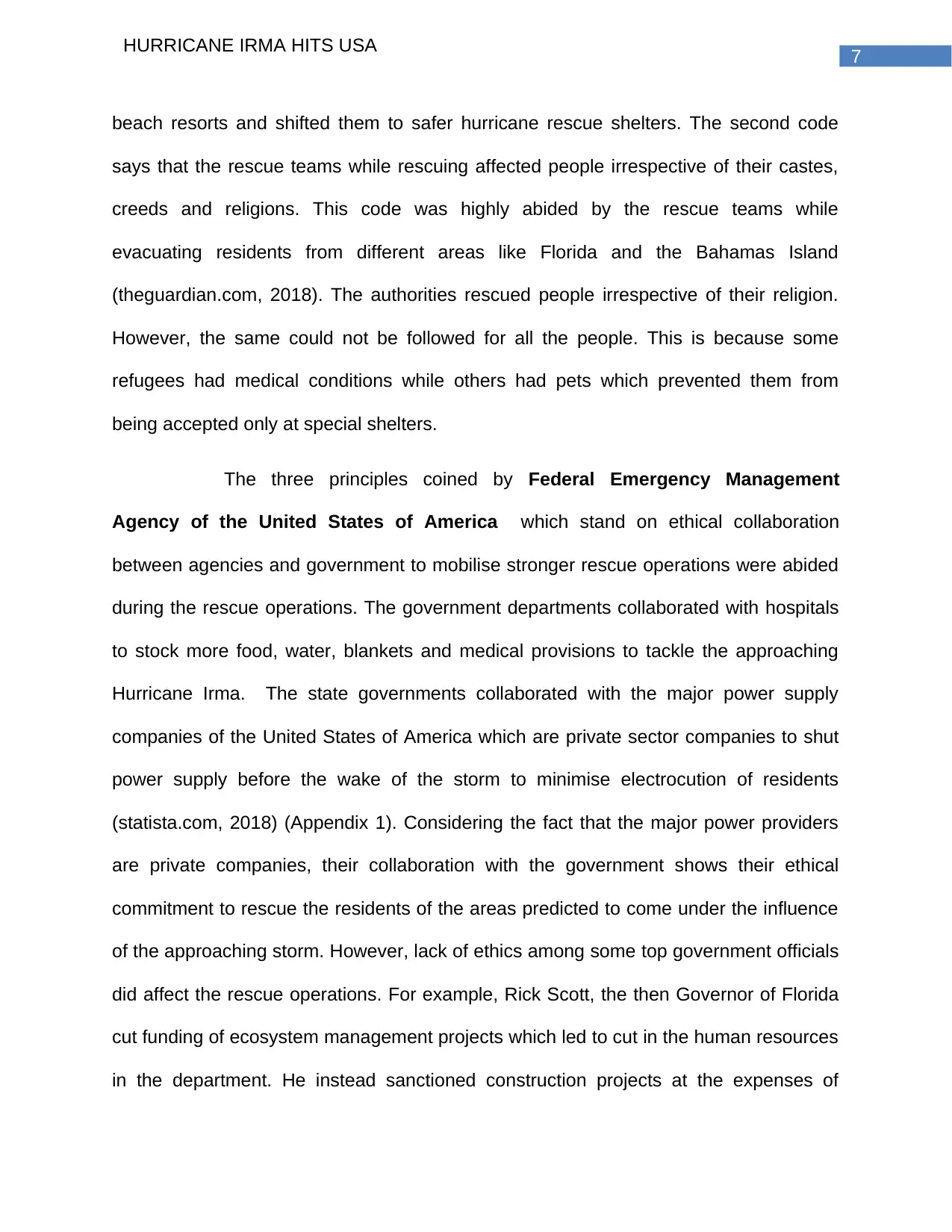
7
HURRICANE IRMA HITS USA
beach resorts and shifted them to safer hurricane rescue shelters. The second code
says that the rescue teams while rescuing affected people irrespective of their castes,
creeds and religions. This code was highly abided by the rescue teams while
evacuating residents from different areas like Florida and the Bahamas Island
(theguardian.com, 2018). The authorities rescued people irrespective of their religion.
However, the same could not be followed for all the people. This is because some
refugees had medical conditions while others had pets which prevented them from
being accepted only at special shelters.
The three principles coined by Federal Emergency Management
Agency of the United States of America which stand on ethical collaboration
between agencies and government to mobilise stronger rescue operations were abided
during the rescue operations. The government departments collaborated with hospitals
to stock more food, water, blankets and medical provisions to tackle the approaching
Hurricane Irma. The state governments collaborated with the major power supply
companies of the United States of America which are private sector companies to shut
power supply before the wake of the storm to minimise electrocution of residents
(statista.com, 2018) (Appendix 1). Considering the fact that the major power providers
are private companies, their collaboration with the government shows their ethical
commitment to rescue the residents of the areas predicted to come under the influence
of the approaching storm. However, lack of ethics among some top government officials
did affect the rescue operations. For example, Rick Scott, the then Governor of Florida
cut funding of ecosystem management projects which led to cut in the human resources
in the department. He instead sanctioned construction projects at the expenses of
HURRICANE IRMA HITS USA
beach resorts and shifted them to safer hurricane rescue shelters. The second code
says that the rescue teams while rescuing affected people irrespective of their castes,
creeds and religions. This code was highly abided by the rescue teams while
evacuating residents from different areas like Florida and the Bahamas Island
(theguardian.com, 2018). The authorities rescued people irrespective of their religion.
However, the same could not be followed for all the people. This is because some
refugees had medical conditions while others had pets which prevented them from
being accepted only at special shelters.
The three principles coined by Federal Emergency Management
Agency of the United States of America which stand on ethical collaboration
between agencies and government to mobilise stronger rescue operations were abided
during the rescue operations. The government departments collaborated with hospitals
to stock more food, water, blankets and medical provisions to tackle the approaching
Hurricane Irma. The state governments collaborated with the major power supply
companies of the United States of America which are private sector companies to shut
power supply before the wake of the storm to minimise electrocution of residents
(statista.com, 2018) (Appendix 1). Considering the fact that the major power providers
are private companies, their collaboration with the government shows their ethical
commitment to rescue the residents of the areas predicted to come under the influence
of the approaching storm. However, lack of ethics among some top government officials
did affect the rescue operations. For example, Rick Scott, the then Governor of Florida
cut funding of ecosystem management projects which led to cut in the human resources
in the department. He instead sanctioned construction projects at the expenses of
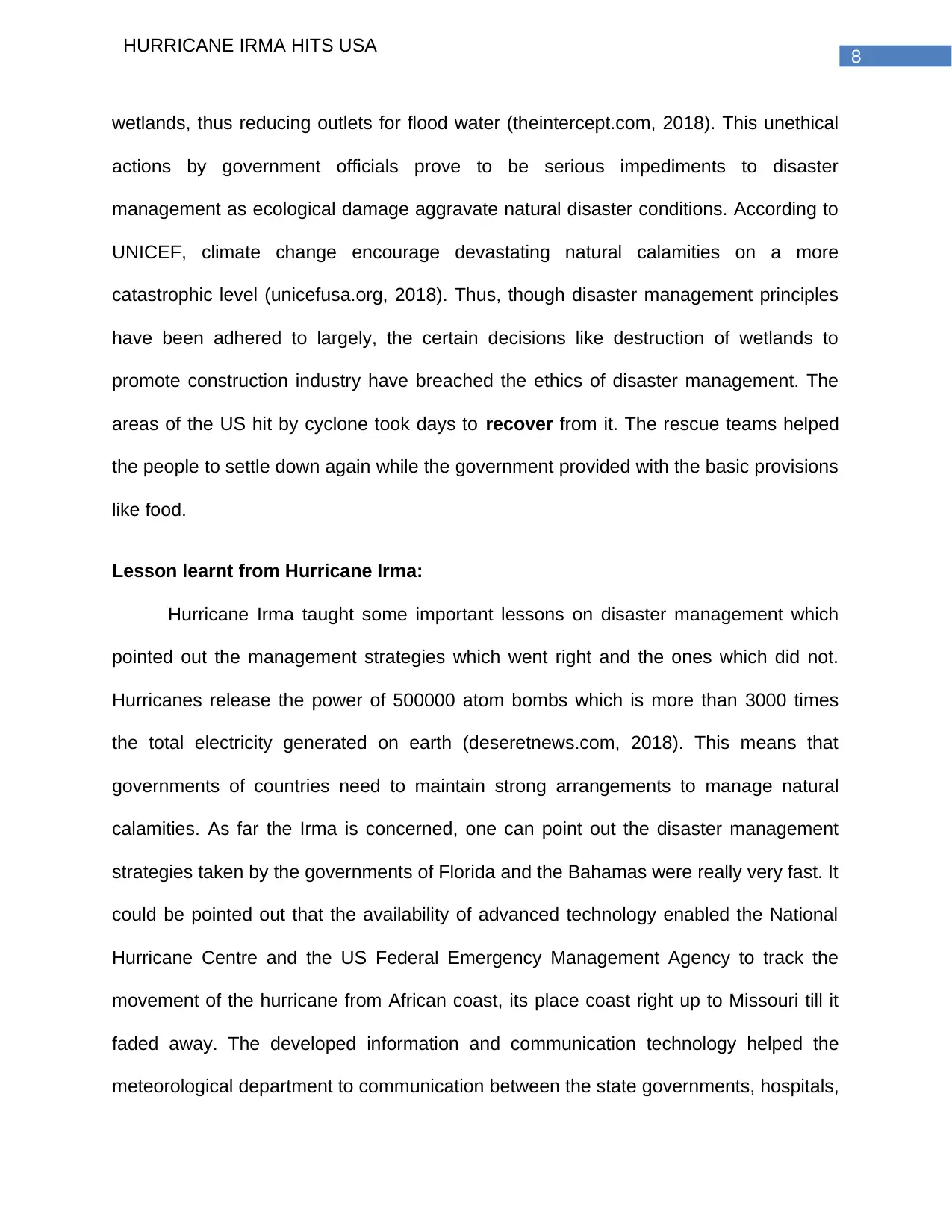
8
HURRICANE IRMA HITS USA
wetlands, thus reducing outlets for flood water (theintercept.com, 2018). This unethical
actions by government officials prove to be serious impediments to disaster
management as ecological damage aggravate natural disaster conditions. According to
UNICEF, climate change encourage devastating natural calamities on a more
catastrophic level (unicefusa.org, 2018). Thus, though disaster management principles
have been adhered to largely, the certain decisions like destruction of wetlands to
promote construction industry have breached the ethics of disaster management. The
areas of the US hit by cyclone took days to recover from it. The rescue teams helped
the people to settle down again while the government provided with the basic provisions
like food.
Lesson learnt from Hurricane Irma:
Hurricane Irma taught some important lessons on disaster management which
pointed out the management strategies which went right and the ones which did not.
Hurricanes release the power of 500000 atom bombs which is more than 3000 times
the total electricity generated on earth (deseretnews.com, 2018). This means that
governments of countries need to maintain strong arrangements to manage natural
calamities. As far the Irma is concerned, one can point out the disaster management
strategies taken by the governments of Florida and the Bahamas were really very fast. It
could be pointed out that the availability of advanced technology enabled the National
Hurricane Centre and the US Federal Emergency Management Agency to track the
movement of the hurricane from African coast, its place coast right up to Missouri till it
faded away. The developed information and communication technology helped the
meteorological department to communication between the state governments, hospitals,
HURRICANE IRMA HITS USA
wetlands, thus reducing outlets for flood water (theintercept.com, 2018). This unethical
actions by government officials prove to be serious impediments to disaster
management as ecological damage aggravate natural disaster conditions. According to
UNICEF, climate change encourage devastating natural calamities on a more
catastrophic level (unicefusa.org, 2018). Thus, though disaster management principles
have been adhered to largely, the certain decisions like destruction of wetlands to
promote construction industry have breached the ethics of disaster management. The
areas of the US hit by cyclone took days to recover from it. The rescue teams helped
the people to settle down again while the government provided with the basic provisions
like food.
Lesson learnt from Hurricane Irma:
Hurricane Irma taught some important lessons on disaster management which
pointed out the management strategies which went right and the ones which did not.
Hurricanes release the power of 500000 atom bombs which is more than 3000 times
the total electricity generated on earth (deseretnews.com, 2018). This means that
governments of countries need to maintain strong arrangements to manage natural
calamities. As far the Irma is concerned, one can point out the disaster management
strategies taken by the governments of Florida and the Bahamas were really very fast. It
could be pointed out that the availability of advanced technology enabled the National
Hurricane Centre and the US Federal Emergency Management Agency to track the
movement of the hurricane from African coast, its place coast right up to Missouri till it
faded away. The developed information and communication technology helped the
meteorological department to communication between the state governments, hospitals,
⊘ This is a preview!⊘
Do you want full access?
Subscribe today to unlock all pages.

Trusted by 1+ million students worldwide
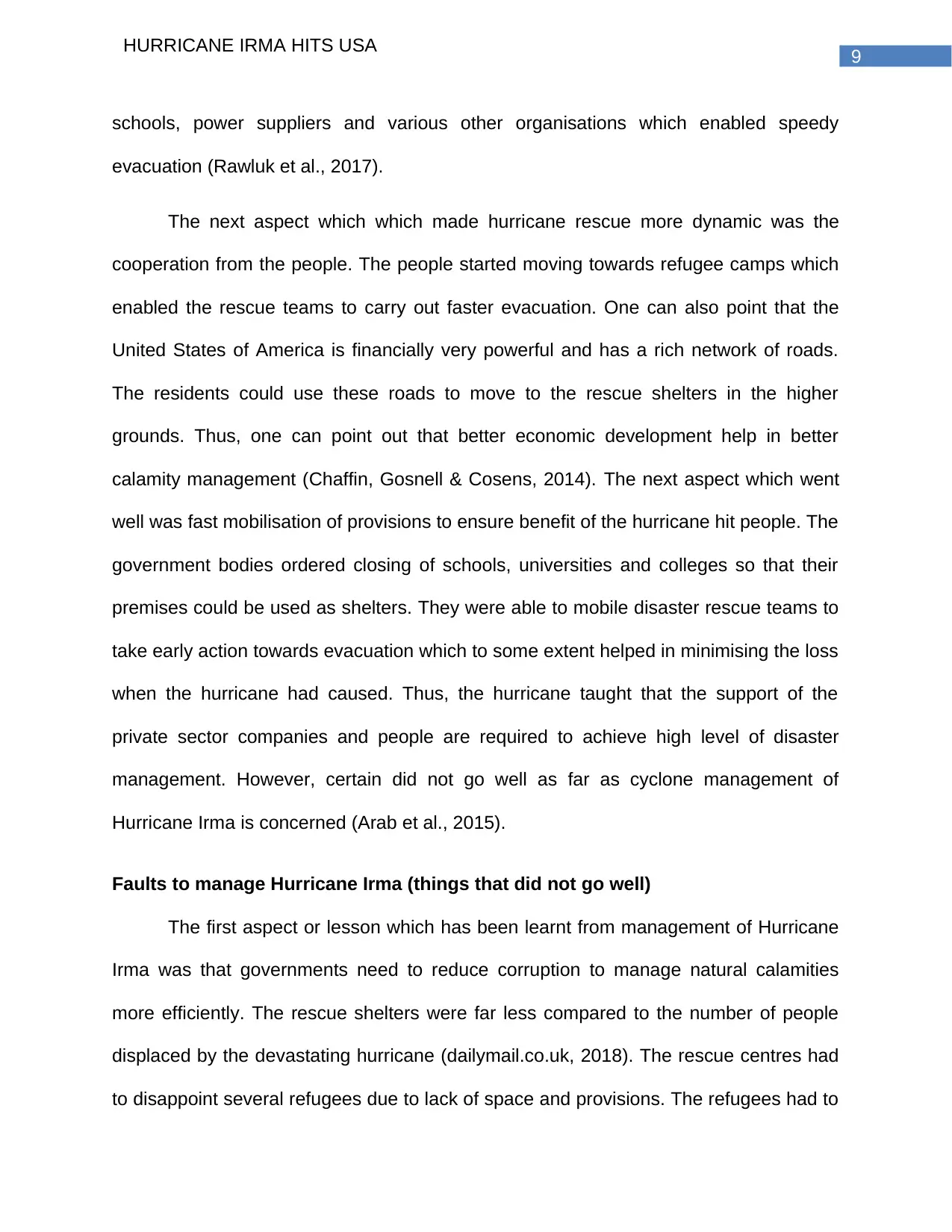
9
HURRICANE IRMA HITS USA
schools, power suppliers and various other organisations which enabled speedy
evacuation (Rawluk et al., 2017).
The next aspect which which made hurricane rescue more dynamic was the
cooperation from the people. The people started moving towards refugee camps which
enabled the rescue teams to carry out faster evacuation. One can also point that the
United States of America is financially very powerful and has a rich network of roads.
The residents could use these roads to move to the rescue shelters in the higher
grounds. Thus, one can point out that better economic development help in better
calamity management (Chaffin, Gosnell & Cosens, 2014). The next aspect which went
well was fast mobilisation of provisions to ensure benefit of the hurricane hit people. The
government bodies ordered closing of schools, universities and colleges so that their
premises could be used as shelters. They were able to mobile disaster rescue teams to
take early action towards evacuation which to some extent helped in minimising the loss
when the hurricane had caused. Thus, the hurricane taught that the support of the
private sector companies and people are required to achieve high level of disaster
management. However, certain did not go well as far as cyclone management of
Hurricane Irma is concerned (Arab et al., 2015).
Faults to manage Hurricane Irma (things that did not go well)
The first aspect or lesson which has been learnt from management of Hurricane
Irma was that governments need to reduce corruption to manage natural calamities
more efficiently. The rescue shelters were far less compared to the number of people
displaced by the devastating hurricane (dailymail.co.uk, 2018). The rescue centres had
to disappoint several refugees due to lack of space and provisions. The refugees had to
HURRICANE IRMA HITS USA
schools, power suppliers and various other organisations which enabled speedy
evacuation (Rawluk et al., 2017).
The next aspect which which made hurricane rescue more dynamic was the
cooperation from the people. The people started moving towards refugee camps which
enabled the rescue teams to carry out faster evacuation. One can also point that the
United States of America is financially very powerful and has a rich network of roads.
The residents could use these roads to move to the rescue shelters in the higher
grounds. Thus, one can point out that better economic development help in better
calamity management (Chaffin, Gosnell & Cosens, 2014). The next aspect which went
well was fast mobilisation of provisions to ensure benefit of the hurricane hit people. The
government bodies ordered closing of schools, universities and colleges so that their
premises could be used as shelters. They were able to mobile disaster rescue teams to
take early action towards evacuation which to some extent helped in minimising the loss
when the hurricane had caused. Thus, the hurricane taught that the support of the
private sector companies and people are required to achieve high level of disaster
management. However, certain did not go well as far as cyclone management of
Hurricane Irma is concerned (Arab et al., 2015).
Faults to manage Hurricane Irma (things that did not go well)
The first aspect or lesson which has been learnt from management of Hurricane
Irma was that governments need to reduce corruption to manage natural calamities
more efficiently. The rescue shelters were far less compared to the number of people
displaced by the devastating hurricane (dailymail.co.uk, 2018). The rescue centres had
to disappoint several refugees due to lack of space and provisions. The refugees had to
Paraphrase This Document
Need a fresh take? Get an instant paraphrase of this document with our AI Paraphraser
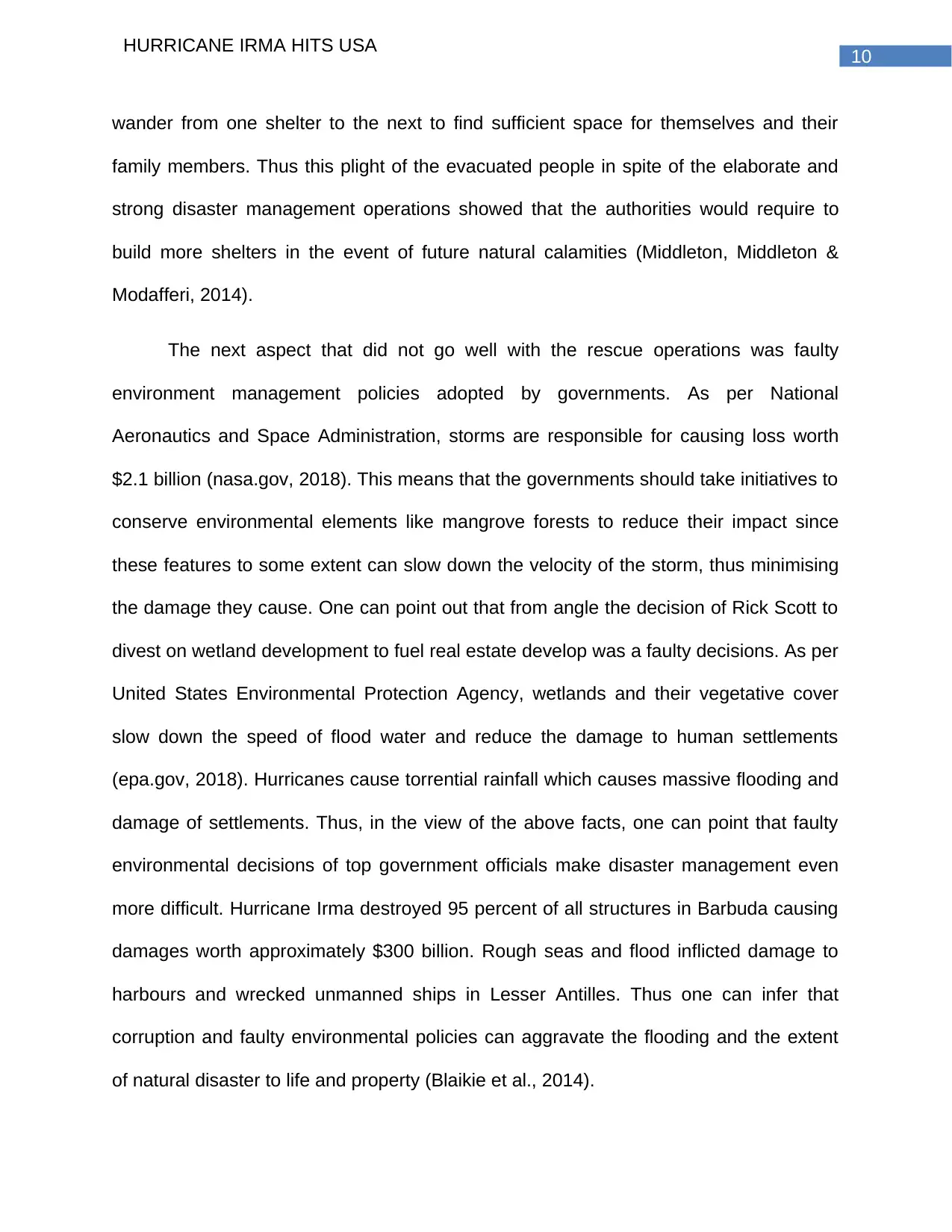
10
HURRICANE IRMA HITS USA
wander from one shelter to the next to find sufficient space for themselves and their
family members. Thus this plight of the evacuated people in spite of the elaborate and
strong disaster management operations showed that the authorities would require to
build more shelters in the event of future natural calamities (Middleton, Middleton &
Modafferi, 2014).
The next aspect that did not go well with the rescue operations was faulty
environment management policies adopted by governments. As per National
Aeronautics and Space Administration, storms are responsible for causing loss worth
$2.1 billion (nasa.gov, 2018). This means that the governments should take initiatives to
conserve environmental elements like mangrove forests to reduce their impact since
these features to some extent can slow down the velocity of the storm, thus minimising
the damage they cause. One can point out that from angle the decision of Rick Scott to
divest on wetland development to fuel real estate develop was a faulty decisions. As per
United States Environmental Protection Agency, wetlands and their vegetative cover
slow down the speed of flood water and reduce the damage to human settlements
(epa.gov, 2018). Hurricanes cause torrential rainfall which causes massive flooding and
damage of settlements. Thus, in the view of the above facts, one can point that faulty
environmental decisions of top government officials make disaster management even
more difficult. Hurricane Irma destroyed 95 percent of all structures in Barbuda causing
damages worth approximately $300 billion. Rough seas and flood inflicted damage to
harbours and wrecked unmanned ships in Lesser Antilles. Thus one can infer that
corruption and faulty environmental policies can aggravate the flooding and the extent
of natural disaster to life and property (Blaikie et al., 2014).
HURRICANE IRMA HITS USA
wander from one shelter to the next to find sufficient space for themselves and their
family members. Thus this plight of the evacuated people in spite of the elaborate and
strong disaster management operations showed that the authorities would require to
build more shelters in the event of future natural calamities (Middleton, Middleton &
Modafferi, 2014).
The next aspect that did not go well with the rescue operations was faulty
environment management policies adopted by governments. As per National
Aeronautics and Space Administration, storms are responsible for causing loss worth
$2.1 billion (nasa.gov, 2018). This means that the governments should take initiatives to
conserve environmental elements like mangrove forests to reduce their impact since
these features to some extent can slow down the velocity of the storm, thus minimising
the damage they cause. One can point out that from angle the decision of Rick Scott to
divest on wetland development to fuel real estate develop was a faulty decisions. As per
United States Environmental Protection Agency, wetlands and their vegetative cover
slow down the speed of flood water and reduce the damage to human settlements
(epa.gov, 2018). Hurricanes cause torrential rainfall which causes massive flooding and
damage of settlements. Thus, in the view of the above facts, one can point that faulty
environmental decisions of top government officials make disaster management even
more difficult. Hurricane Irma destroyed 95 percent of all structures in Barbuda causing
damages worth approximately $300 billion. Rough seas and flood inflicted damage to
harbours and wrecked unmanned ships in Lesser Antilles. Thus one can infer that
corruption and faulty environmental policies can aggravate the flooding and the extent
of natural disaster to life and property (Blaikie et al., 2014).
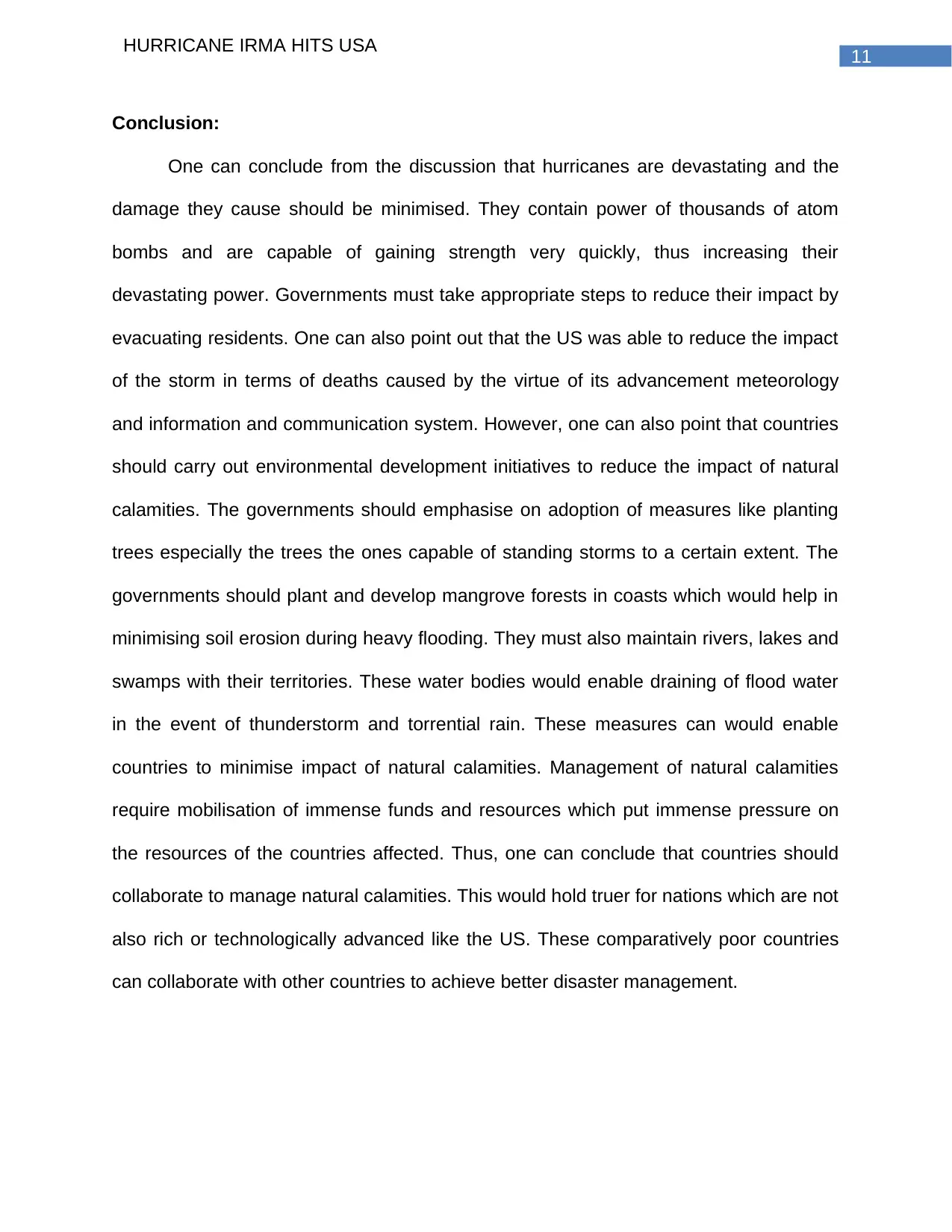
11
HURRICANE IRMA HITS USA
Conclusion:
One can conclude from the discussion that hurricanes are devastating and the
damage they cause should be minimised. They contain power of thousands of atom
bombs and are capable of gaining strength very quickly, thus increasing their
devastating power. Governments must take appropriate steps to reduce their impact by
evacuating residents. One can also point out that the US was able to reduce the impact
of the storm in terms of deaths caused by the virtue of its advancement meteorology
and information and communication system. However, one can also point that countries
should carry out environmental development initiatives to reduce the impact of natural
calamities. The governments should emphasise on adoption of measures like planting
trees especially the trees the ones capable of standing storms to a certain extent. The
governments should plant and develop mangrove forests in coasts which would help in
minimising soil erosion during heavy flooding. They must also maintain rivers, lakes and
swamps with their territories. These water bodies would enable draining of flood water
in the event of thunderstorm and torrential rain. These measures can would enable
countries to minimise impact of natural calamities. Management of natural calamities
require mobilisation of immense funds and resources which put immense pressure on
the resources of the countries affected. Thus, one can conclude that countries should
collaborate to manage natural calamities. This would hold truer for nations which are not
also rich or technologically advanced like the US. These comparatively poor countries
can collaborate with other countries to achieve better disaster management.
HURRICANE IRMA HITS USA
Conclusion:
One can conclude from the discussion that hurricanes are devastating and the
damage they cause should be minimised. They contain power of thousands of atom
bombs and are capable of gaining strength very quickly, thus increasing their
devastating power. Governments must take appropriate steps to reduce their impact by
evacuating residents. One can also point out that the US was able to reduce the impact
of the storm in terms of deaths caused by the virtue of its advancement meteorology
and information and communication system. However, one can also point that countries
should carry out environmental development initiatives to reduce the impact of natural
calamities. The governments should emphasise on adoption of measures like planting
trees especially the trees the ones capable of standing storms to a certain extent. The
governments should plant and develop mangrove forests in coasts which would help in
minimising soil erosion during heavy flooding. They must also maintain rivers, lakes and
swamps with their territories. These water bodies would enable draining of flood water
in the event of thunderstorm and torrential rain. These measures can would enable
countries to minimise impact of natural calamities. Management of natural calamities
require mobilisation of immense funds and resources which put immense pressure on
the resources of the countries affected. Thus, one can conclude that countries should
collaborate to manage natural calamities. This would hold truer for nations which are not
also rich or technologically advanced like the US. These comparatively poor countries
can collaborate with other countries to achieve better disaster management.
⊘ This is a preview!⊘
Do you want full access?
Subscribe today to unlock all pages.

Trusted by 1+ million students worldwide
1 out of 19
Related Documents
Your All-in-One AI-Powered Toolkit for Academic Success.
+13062052269
info@desklib.com
Available 24*7 on WhatsApp / Email
![[object Object]](/_next/static/media/star-bottom.7253800d.svg)
Unlock your academic potential
Copyright © 2020–2025 A2Z Services. All Rights Reserved. Developed and managed by ZUCOL.



